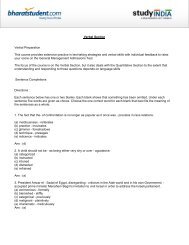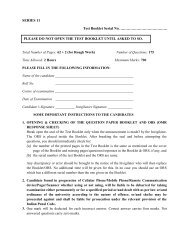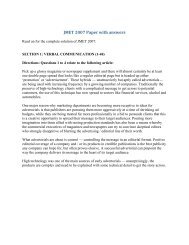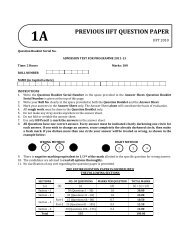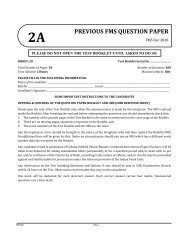JMET 2009 - Testfunda
JMET 2009 - Testfunda
JMET 2009 - Testfunda
Create successful ePaper yourself
Turn your PDF publications into a flip-book with our unique Google optimized e-Paper software.
SECTION 1: VERBAL COMMUNICATION (Questions 1 - 30)<br />
Direction: Questions 1 – 4 relate to the passage given below:<br />
Can poor countries afford to be green? That is a question which politicians in the developing world have<br />
often asked pointedly. To them, it seems that the obsession of some rich type with preserving forests and<br />
saving cuddly animals like pandas or lemurs, while paying less attention to the human brings living<br />
nearby, is both cynical and hypocritical. There is of course plenty of evidence that greenery and growth<br />
are not polar opposite. After decades of expansion in China and other fast-emerging economies, some of<br />
the negative side-effects and their impact on human welfare, above all the death toll caused by foul air<br />
and water, are horribly clear. Yet the relationship between growth and the state of environment is far<br />
from simple. Some experts feel that poor countries have been quiet right to challenge the sort of green<br />
orthodox which rejects the very idea of economic growth. Indeed, the single biggest variable in<br />
determining the countries ranking is income per head. But that doesn‘t imply that economic growth<br />
automatically leads to an improvement in the environment. Growth does offer solutions to the sorts of<br />
environmental woes (local air pollution, for example) that directly kill humans. This matters, because<br />
about a quarter of all deaths in the world have some link to environmental factors. Most of the victims<br />
are poor people who are already vulnerable because of bad living conditions, lack of access to medicine,<br />
and malnutrition. Among the killers especially of children, in which the environment plays the role, are<br />
diarrhoea, respiratory and infections and malaria. These diseases reinforce a vicious circle of poverty<br />
and hopelessness by depressing production. According to the World Bank, the economic burden on<br />
society caused by bad environmental health amounts to between 2% and 5% of GDP. As poor countries<br />
get richer, they usually invest heavily in environmental improvements, such as cleaning up water<br />
supplies and improving sanitation, that boost human health. But the link between growth and<br />
environmentally benign outcomes is much less clear when it comes to the sort of pollution that fouls up<br />
nature (such as acid rain, which poisons lakes and forests) as opposed to directly killing human beings.<br />
The key to addressing that sort of pollution is not just money but good governance. Hence the poor<br />
Dominican Republic is much healthier than nearby Haiti, Costa Rica is far ahead of Nicaragua, in spite<br />
of broadly similar nature and resources, and wealthy Belgium is the sick man of Western Europe, with<br />
an environmental record worse than that of many developing countries.<br />
Q.1 The passage DOES NOT talk about:<br />
(A) the impact of environmental health on economic growth.<br />
(B) factors determining good governance.<br />
(C) the impact of economic growth on environment health.<br />
(D) environmental factors affecting child mortality.<br />
Q.2 Which one of the following statements CANNOT be inferred from the passage?<br />
(A) Fast-emerging economies are responsible for polluting their environment.<br />
(B) Bad environmental health affects a country‘s production.<br />
(C) Environment can be protected only after economic prosperity has been achieved.<br />
(D) The link between the state of the environment and human health is ambiguous.<br />
B 2/36



